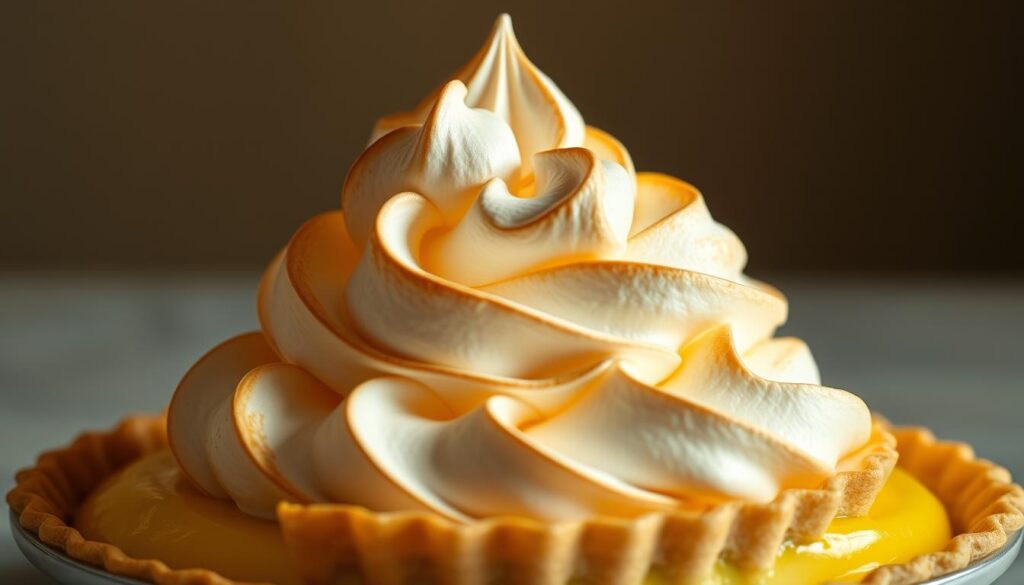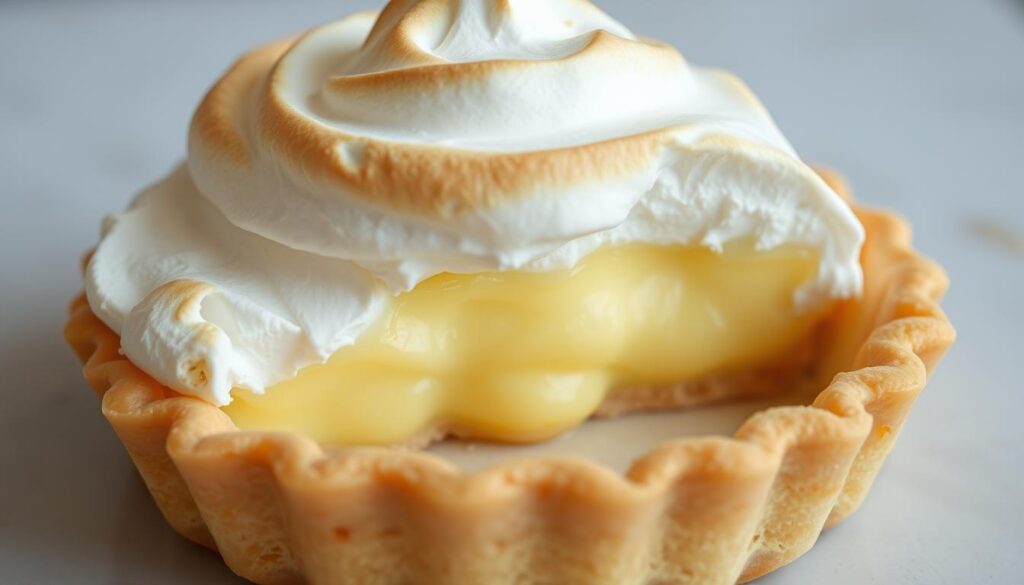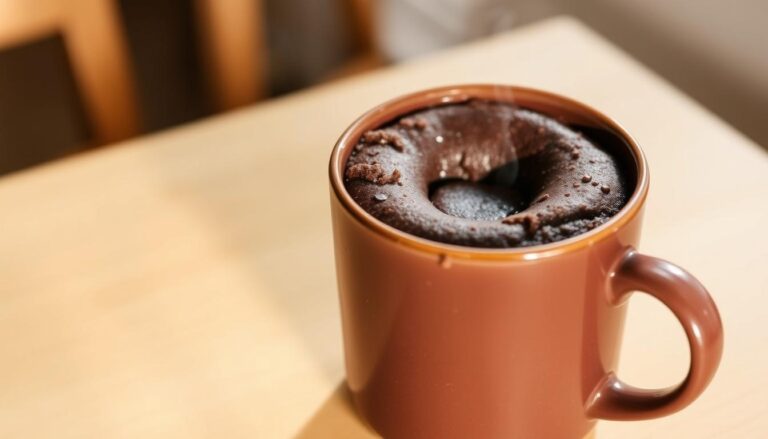Are you ready to elevate your dessert game with a classic lemon meringue pie? This beloved treat is a staple in many American households, but achieving the perfect balance of tangy and sweet can be challenging.
To help you master this iconic pie, we’ll reveal five essential secrets that will transform your baking experience. By understanding the science behind each component, you’ll be able to create a meringue that’s light and fluffy, a lemon filling that’s tart and creamy, and a crust that’s perfectly baked.
With these expert tips, you’ll be well on your way to creating a show-stopping pie that’s sure to impress your family and friends. Let’s dive into the secrets that will take your lemon meringue pie to the next level.
Table of Contents
The Allure of Lemon Meringue Pie
With its rich history and striking visual appeal, lemon meringue pie remains a quintessential American dessert that never fails to impress. This classic dessert has been a staple in American cuisine for generations, captivating audiences with its unique blend of flavors and textures.
A Classic American Dessert
Lemon meringue pie has a long history that dates back to the early days of American baking. It’s a dessert that has graced family tables for decades, offering a complex flavor profile that delights both bakers and dessert enthusiasts alike. The pie represents a perfect marriage of contrasting elements: the buttery crust, the bright acidic lemon filling, and the sweet billowy meringue.
The Perfect Balance of Sweet and Tart
The allure of lemon meringue lies in its perfect balance of sweet and tart, a characteristic that has made it a beloved dessert across the United States. When you take your first cut through the toasted meringue topping, the smooth, tart filling beneath is a true delight. This recipe balances sweetness and acidity in perfect harmony, creating a dessert that satisfies multiple taste preferences simultaneously.
Mastering lemon meringue pie is considered a milestone achievement for home bakers and professional pastry chefs alike, due to the precision required in crafting its various components.
Secret #1: Mastering the Perfect Pie Crust
The key to a successful lemon meringue pie lies in mastering the art of making the perfect pie crust. A well-made crust is not just about aesthetics; it’s crucial for the texture and overall presentation of your dessert.
Blind Baking Essentials
To avoid a soggy crust, it’s essential to partially blind bake it before adding the lemon filling. Start by lining your frozen pie crust with aluminum foil, ensuring it extends over the edges for easy removal. Fill the foil-lined crust two-thirds full with pie weights or dry beans. This step is crucial for maintaining the crust’s shape during baking.
Bake the crust in a preheated oven for 20 minutes. After removing the foil and pie weights, use a fork to poke the bottom of the crust in several places. This technique, known as docking, prevents the crust from bubbling up.
Creating a Moisture-Proof Barrier
A critical step in ensuring your pie remains crisp is creating a barrier between the crust and the filling. This prevents the liquid filling from seeping into the crust, keeping it crisp.
| Technique | Purpose |
|---|---|
| Blind Baking | Prevents soggy crust |
| Docking | Prevents crust bubbling |
| Moisture Barrier | Keeps crust crisp |
By mastering these techniques, you’ll be well on your way to creating a pie that’s both visually appealing and delicious. Follow these steps for a successful recipe, and you’ll enjoy a perfectly baked lemon meringue pie.
Secret #2: Achieving the Ideal Lemon Filling Consistency
The key to a sublime lemon meringue pie experience is getting the lemon filling just right. A perfectly balanced lemon filling should be creamy, smooth, and stable enough to hold its shape when sliced.
Understanding the science behind creating a non-watery filling is crucial. According to Shirley Corriher, author of “Cookwise,” the problem with many lemon meringue pies is the enzymatic reaction between egg yolks and cornstarch, which can result in a runny filling. To avoid this, it’s essential to bring the mixture to a boil to deactivate the enzyme.
The Science Behind a Non-Watery Filling
The lemon meringue pie filling is essentially a thinner version of lemon curd. To achieve the right consistency, you need to balance lemon juice, water, cornstarch, and sugar. The ratio of these ingredients is critical, as is the method of preparation.
When you combine egg yolks with the starch mixture and apply medium heat in a saucepan, the starch prevents the egg yolks from curdling when boiled. This process is crucial for achieving a smooth, properly thickened filling.
| Ingredient | Role in Filling Consistency |
|---|---|
| Lemon Juice | Provides flavor and contributes to the filling’s consistency |
| Water | Dilutes the mixture to the right thickness |
| Cornstarch | Thickens the filling and prevents egg yolks from curdling |
| Sugar | Balances the tartness of the lemon juice |
| Egg Yolks | Enriches the filling and contributes to its thickness |
Properly Tempering Egg Yolks
Tempering egg yolks is a critical step in making the lemon meringue filling. It involves gradually introducing the hot mixture to the egg yolks to prevent curdling. This technique ensures a smooth and creamy texture.
By understanding the science behind the filling’s consistency and mastering the technique of tempering egg yolks, you can create a lemon meringue pie that is both delicious and visually appealing.
Secret #3: Crafting a Stable, Mile-High Meringue
The secret to a towering, stable meringue lies in understanding the science behind its preparation. A well-crafted meringue is not just aesthetically pleasing; it’s also a crucial component of a lemon meringue pie that impresses. To achieve this, you need to focus on a few key factors that contribute to the stability and structure of your meringue topping.
Room Temperature Egg Whites: The Foundation of Success
Using room temperature egg whites is essential for achieving maximum volume and stability in your meringue. When egg whites are at room temperature, they whip faster and into a greater volume than cold egg whites. This simple step can make a significant difference in the quality of your meringue. Ensure your egg whites are free from any fat, as even a trace amount can prevent them from whipping properly.
The Role of Cream of Tartar
Cream of tartar plays a critical role as an acid stabilizer that helps egg whites maintain their structure during and after whipping. Adding cream of tartar to your egg whites enhances their stability, making it easier to achieve stiff, glossy peaks. This ingredient is a simple yet effective way to improve the overall quality of your meringue.
Achieving Stiff, Glossy Peaks
To create a stable meringue, it’s crucial to master the technique of gradually adding sugar to whipped egg whites at precisely the right moment. This process helps to create a glossy, stable meringue that holds its shape. Understanding the visual cues for soft peaks versus stiff peaks is also vital; stopping at the right stage is crucial for meringue success. A professional baker’s trick is to add a cornstarch gel to your meringue for additional stability, preventing weeping and shrinking.
When whipping egg whites, it’s essential to use a completely clean and fat-free bowl and whisk. Any residual fat can prevent the egg whites from whipping properly, leading to a subpar meringue. By following these tips and understanding the importance of each component, you can create a meringue that’s both stable and visually appealing.

Secret #4: Preventing the Dreaded Weeping Meringue
Preventing a weeping meringue requires attention to detail and a few simple techniques that ensure your lemon meringue pie remains visually appealing and delicious. Weeping meringue occurs when moisture beads on the surface or between the filling and meringue, ruining the texture and appearance of your pie.
To avoid this issue, it’s crucial to understand the causes and implement preventive measures. One of the primary reasons for weeping meringue is the separation of the meringue from the filling due to improper sealing or temperature differences.
Sealing the Edges Properly
Properly sealing the edges of the meringue to the crust is essential. This involves spreading the meringue topping so it touches the pie crust, creating a barrier that prevents the lemon filling from escaping and causing weeping. Ensure the meringue is in contact with the crust all around the edge to achieve a good seal.
The Cornstarch Stabilizing Method
Another effective method to prevent weeping is by using cornstarch to stabilize the meringue. Professional bakers often use this technique to ensure their meringues remain stable and dry. By adding a small amount of cornstarch to the sugar, you can absorb excess moisture and reduce the likelihood of weeping.
| Method | Description | Effectiveness |
|---|---|---|
| Sealing Edges | Spreading meringue to touch the crust | High |
| Cornstarch Stabilizing | Adding cornstarch to sugar | High |
| Temperature Control | Managing temperature differences | Medium |
By implementing these techniques, you can significantly reduce the risk of weeping meringue and achieve a beautifully presented lemon meringue pie.
Secret #5: Perfect Baking and Cooling Techniques
A perfectly baked and cooled lemon meringue pie is the result of careful technique and patience. To achieve this, you need to master two critical steps: baking the pie to perfection and cooling it properly.
Finding the Ideal Oven Temperature
Baking your lemon meringue pie at the right temperature is crucial. While many recipes suggest using the broiler to brown the meringue, baking it in the oven allows the egg whites to cook through thoroughly. This method prevents the meringue from being undercooked beneath a browned surface. To achieve a beautifully browned meringue without burning, you must master the perfect baking temperature and timing.

The Importance of Complete Cooling
After baking, allowing your meringue pie to cool completely is essential. This step ensures that the filling sets properly, preventing a runny consistency when you slice the pie. Cooling your pie at room temperature for 2-3 hours is recommended. For a more efficient cooling process, you can place the pie on a cooling pack covered with a tea towel to help firm up the base without compromising the texture.
| Baking Technique | Cooling Method | Result |
|---|---|---|
| Baking in the oven | Cooling at room temperature | Fully cooked meringue and set filling |
| Broiler method | Cooling at room temperature | Risk of undercooked meringue |
| Baking in the oven | Using a cooling pack | Faster firming of the filling |
Proper storage is also vital. While your lemon meringue pie is best consumed on the same day it’s made, leftovers can be stored in the refrigerator, loosely covered with plastic wrap, for up to 2-3 days. However, be aware that the meringue may weep over time.
Complete Lemon Meringue Pie Recipe
Now that we’ve covered the essential secrets, it’s time to put them into practice with our complete lemon meringue pie recipe. This comprehensive guide will walk you through every step, from preparing the crust to topping it with a fluffy meringue.
Ingredients List
To make this showstopping dessert, you’ll need the following ingredients:
For the Crust
You’ll need a homemade pie crust, which you can prepare ahead of time.
For the Lemon Filling
- 5 large egg yolks
- 1 and 1/3 cups water
- 1 cup granulated sugar
- 1/3 cup cornstarch
- 1/4 teaspoon salt
- 1/2 cup fresh lemon juice
- 1 Tablespoon lemon zest
- 2 Tablespoons unsalted butter, softened
For the Meringue Topping
- 5 large egg whites, at room temperature
- 1/2 teaspoon cream of tartar
- 1/2 cup granulated sugar
- 1/8 teaspoon salt
- 1 tablespoon cornstarch
- 1/3 cup water
- 1/2 teaspoon vanilla extract
Step-by-Step Instructions
Preparing and Blind Baking the Crust
Prepare your pie dough ahead of time and chill it for at least 2 hours. Preheat your oven to 375°F (190°C), then partially blind bake the crust in a 9-inch pie dish.
Making the Lemon Filling
Whisk together egg yolks, water, sugar, cornstarch, salt, lemon juice, and zest in a saucepan. Cook over medium heat until thickened, then temper the egg yolks and whisk in butter.
Creating and Topping with Meringue
Beat egg whites and cream of tartar until soft peaks form. Gradually add sugar and continue beating until stiff peaks form. Spread the meringue over the filling, ensuring it touches the crust edges.
| Component | Key Ingredients | Critical Step |
|---|---|---|
| Crust | Homemade pie dough | Blind baking |
| Lemon Filling | Egg yolks, lemon juice, sugar | Tempering egg yolks |
| Meringue Topping | Egg whites, sugar, cream of tartar | Beating to stiff peaks |
Conclusion
The art of creating a flawless lemon meringue pie is now within your grasp. By understanding the science and techniques behind each component, you’ll celebrate your newfound expertise. Remember, practice makes perfect, and timing is everything when making this dessert.
Share your beautiful pie with friends and family on the same day for the best experience. Apply these secrets to other meringue-topped desserts for equally impressive results.







